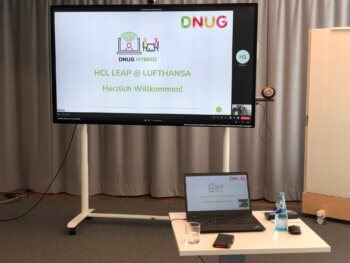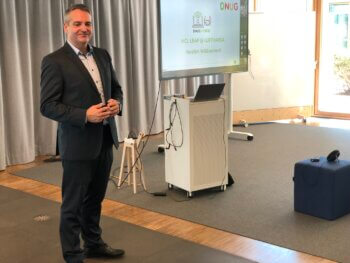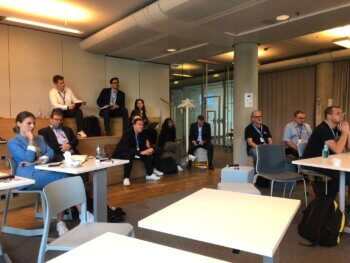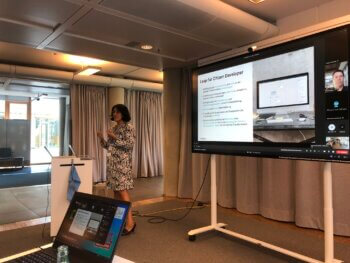Archive for: ‘August 2023’
Erwartungen effektiv managen mit strategischem Conversational Design
Typeahead-Funktion im Chatbot hilft dabei, Fragen präziser zu formulieren
DNUG Hybrid – HCL LEAP @ Lufthansa – Nachbericht

Mehr als 60 Teilnehmer hatten sich für das Event angemeldet, für das wir am 10. August freundlicherweise ins Lufthansa Aviation Center in Frankfurt laden durften. Die sensationellen Räumlichkeiten und der überaus freundliche Empfang durch die Lufthansa waren mehr als genug Lohn dafür, dass 12 Teilnehmer die Reise nach Frankfurt auf sich genommen und vor Ort dabei waren. Während sich die Teilnehmer vor Ort noch am von Lufthansa gesponserten Buffet stärkten, trudelten die Online-Teilnehmer nach und nach ein und um Punkt 14 Uhr eröffneten unsere Vorstände Matthias und Daniel das Event.
Dass auch die Luftfahrtbranche vor großen Herausforderungen im Bereich der Nachhaltigkeit steht, zeigte der einleitende Vortrag von Jona Diederich, seines Zeichens für das Thema Nachhaltigkeit bei der Lufthansa verantwortlich. In gut 30 Minuten beleuchtete er Aspekte, über die sich vermutlich die allerwenigsten Flugreisenden einen Kopf machen, die aber im Hinblick auf die für uns alle wichtigen Klimaziele sehr relevant sind.

Den Hauptvortrag des Nachmittags leitete Ralf Schliepat (Senior Consultant bei Lufthansa Industry Solutions und Project Manager des LEAP Rollouts) mit ein paar Fragen an die Teilnehmer ein. Während tatsächlich einer der Teilnehmer wusste, dass das größte, jemals von Lufthansa transportierte Tier eine Giraffe war, lagen die Schätzungen bei der Anzahl von Geburten während eines Fluges dann doch sehr weit daneben.
Dass es bei Lufthansa immer schon viele Formulare gab, machte Ralf Schliepat dann in einem kurzen Blick in die Vergangenheit deutlich. Wie in vielen anderen Unternehmen auch gab es auch bei Lufthansa von Formularen und Papier überquellende Schreibtische. Um dieser Flut Herr zu werden, aber vermutlich auch um die in der Branche über die Jahre stetig wachsenden Anforderungen in puncto Sicherheit und Dokumentation überhaupt bewältigen zu können, setzte man schon früh auf die elektronische Abbildung von Formularen und Prozessen und setzte dabei auf das seinerzeit noch zu IBM gehörende Produkt „Forms Experience Builder“. Wie so manches andere Produkt auch, hat „Forms Experience Builder“ nach der Übernahme durch HCL einen zweiten Frühling erlebt, sprich, HCL hat dem Produkt nicht nur einen neuen Namen verpasst, sondern es auch überarbeitet und modernisiert. Dies, aber auch die für Lufthansa nicht einfache Pandemie-Zeit haben dafür gesorgt, dass die Anzahl Formulare und Benutzer in den letzten Jahren geradezu exponentiell gewachsen ist. Jeder einzelne der rund 110’000 Lufthansa Mitarbeiter kann ein neues Formular auf der intern „eForms“ genannten Plattform abbilden und damit in seinem Bereich zu mehr Transparenz und Effizienz beitragen. Dass davon rege Gebrauch gemacht wird, zeigen die aktuell rund 2’500 aktiven und die insgesamt gut 11’000 abgebildeten Formulare. Ein großer Teil davon konnte gemäß Ralf Schliepat durch die Mitarbeiter komplett selbst und ohne die von Fall zu Fall hinzugezogene Unterstützung durch einen externen Dienstleister umgesetzt werden.

Für so manchen Teilnehmer interessant dürften die Aussagen von Ralf Schliepat betreffend Qualitätskontrolle und Vermeidung von Duplikation gewesen sein. Weder für das eine noch für das andere gibt es zentrale Stellen, die darüber wachen, dass da alles korrekt ist; jeder Mitarbeiter ist selbst für das verantwortlich, was er auf der Plattform abgebildet hat.
Schließlich nutze Ralf Schliepat – völlig legitim – die Gelegenheit, um noch den ein oder anderen Wunsch an die Plattform zu adressieren.
Nach der anschließenden Pause gab Farnoush Pourebrahim (Senior Account Director DACH Digital Transformation) den Teilnehmern einen Überblick über die in naher Zukunft zu erwartenden Erweiterungen von HCL Leap wie auch deren Integrationspunkte in das Gesamtportfolio von HCLSoftware.

Wie schon beim DNUG Hybrid Event im Mai dieses Jahres wurde das Event bei der Lufthansa durch ein Update aus den DNUG Fachgruppen abgerundet. Vom Ausblick auf die kommende Versionen von Notes/Domino und Sametime über den von der Fachgruppe „Development“ für den November geplanten Workshop zu Volt MX / MX Go bis hin zu Neuerungen im Bereich „BigFix“ wurde den Teilnehmern und komplettes und rundes Update geboten.
Herzlichen Dank für das große Interesse an diesem Event. Gedankt sei auch allen, die dazu in welcher Form auch immer beigetragen haben.
Allen voran möchten wir uns aber bei Ralf Schliepat und Jonas Diederich für ihre Einblicke bedanken und bei Lufthansa für das Gastrecht sowie den überaus freundlichen Empfang.
„Lufthansa – There’s no better way to fly“, das hat schon seine Richtigkeit.
Für den DNUG-Vorstand, Helmut Sproll
Der Beitrag DNUG Hybrid – HCL LEAP @ Lufthansa – Nachbericht erschien zuerst auf DNUG e.V..
Jahresplanung und Mitgliederversammlung
OB VIRTUELL ODER PERSÖNLICH: WIR FREUEN UNS AUF DEINE TEILNAHME!
Zur Jahresplanung bist Du auch dann willkommen, wenn Du kein Mitglied der DNUG bist. Zur Mitgliederversammlung kannst Du auch kommen, wenn Du nicht der Stimmrechtsvertreter Deines Unternehmens bist.
Bitte denk daran, dass Du für die Jahresplanung einen DNUG-Cloud-Zugang benötigst, da wir auch dieses Jahr u.a. wieder mit Huddo Boards planen werden.
Den Antrag auf einen DNUG-Cloud-Zugang findest Du HIER.
Damit Du auch vor Ort aktiv mitmachen kannst, bring bitte Dein Notebook/Mobile Office mit. Auch ohne DNUG-Cloud-Zugang kannst Du Dich aktiv beteiligen. Dann jedoch nicht in vollem Umfang.
Bitte melde Dich per E-Mail unter info@dnug.de an und lass uns wissen, ob Du persönlich oder virtuell teilnimmst und ob Du Interesse an einem gemeinsamen, gemütlichen Abendausklang in einer nahegelegenen Lokalität in Regensburg hast.
Wir freuen uns, Dich am 7. November persönlich oder virtuell zu sehen!
Dein DNUG-Team!
Beginn Jahresplanung: 11:00 Uhr
Beginn Mitgliederversammlung: 17:00 Uhr
Adresse für die persönliche Teilnahme:
marinaforum
Johanna-Dachs-Straße 46
93055 Regensburg
Die Zugangsdaten zum Online-Meeting erhältst Du nach Anmeldung gesondert via E-Mail.
Der Beitrag Jahresplanung und Mitgliederversammlung erschien zuerst auf DNUG e.V..













